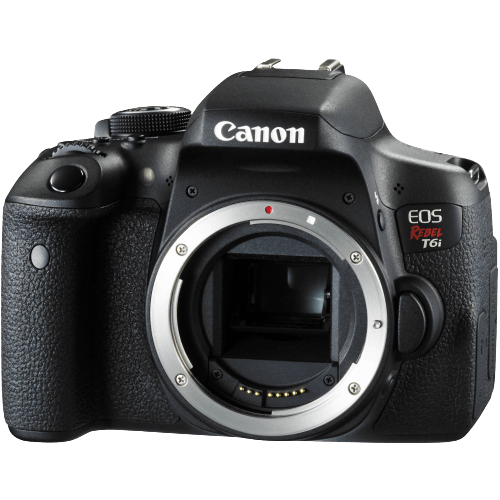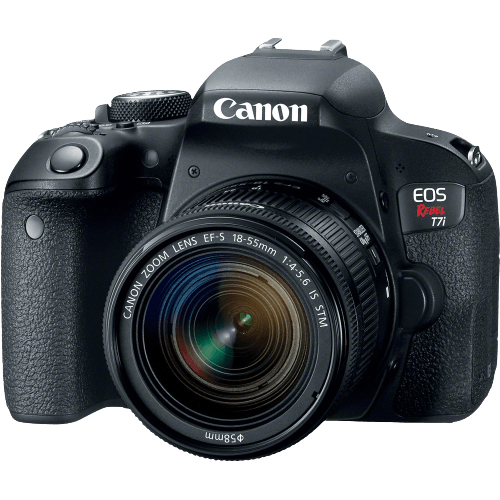Canon EOS Rebel T6i / 750D vs EOS Rebel T7i / 800D Comparison
Canon EOS Rebel T6i / 750D

Canon EOS Rebel T7i / 800D

The Canon EOS Rebel T7i/800D is the winner, scoring 64/100, while the Canon EOS Rebel T6i/750D scored 56/100. Both cameras share common specifications, such as being DSLR cameras with similar launch prices ($750 for T6i and $779 for T7i), and having comparable sizes (T6i: 132x101x78mm, T7i: 131x100x76mm).
The T7i/800D outperforms the T6i/750D with its higher score, indicating a better overall performance. Additionally, the T7i is slightly lighter, weighing 532g compared to the T6i’s 555g, making it more convenient for users to carry around.
On the other hand, the T6i/750D holds its ground as a decent camera, despite its lower score. The difference in scores is not significantly large, and the T6i still offers quality performance at a slightly lower launch price.
Taking everything into account, the Canon EOS Rebel T7i/800D is the superior camera due to its higher score and lighter weight. However, the Canon EOS Rebel T6i/750D remains a viable option for those seeking a more affordable alternative.
Canon EOS Rebel T6i / 750D vs EOS Rebel T7i / 800D Overview and Optics
The Canon EOS Rebel T7i / 800D wins the optics comparison with a score of 64/100, while the Canon EOS Rebel T6i / 750D scores 59/100. Both cameras have several common specifications, such as 24.2 and 24 megapixels, CMOS sensor type, APS-C sensor size, Canon EF-S lens mount, and no image stabilization. However, there are some differences that make the T7i / 800D superior in the optics department.
The T7i / 800D has a faster shooting speed of 6 frames per second (fps), compared to the T6i / 750D’s 5 fps. This allows for capturing fast-moving subjects and action shots more effectively. The T7i / 800D also features a more advanced processor, the Digic 7, which contributes to better image processing, noise reduction, and overall performance. In addition, the T7i / 800D has a higher DXOMARK score for the sensor at 79, compared to the T6i / 750D’s score of 71, indicating better overall image quality.
On the other hand, the T6i / 750D has a slight advantage in megapixels, with 24.2 MP compared to the T7i / 800D’s 24 MP. However, this minor difference has a negligible impact on image quality and is not a significant advantage.
Based on the comparison, the Canon EOS Rebel T7i / 800D is the better camera in terms of optics due to its faster shooting speed, advanced processor, and higher DXOMARK score for the sensor. While the T6i / 750D has a small advantage in megapixels, it is not enough to outweigh the benefits provided by the T7i / 800D. Therefore, the T7i / 800D is the recommended choice for those seeking superior optics performance.
Canon EOS Rebel T6i / 750D vs EOS Rebel T7i / 800D Video Performance
The Canon EOS Rebel T7i / 800D emerges as the superior camera in terms of video capabilities, scoring 70/100 compared to the Canon EOS Rebel T6i / 750D’s score of 43/100. Both cameras share certain video specifications, such as Full HD maximum video resolution and 1920 x 1080 maximum video dimensions.
The T7i / 800D outperforms the T6i / 750D in two notable areas. First, it offers a higher maximum video frame rate of 60fps, compared to the 30fps of the T6i / 750D. This higher frame rate enables smoother and more detailed video capture, particularly in fast-moving situations. Second, the T7i / 800D has built-in time-lapse functionality, which the T6i / 750D lacks. This feature allows for creative and dynamic time-lapse videos without the need for additional equipment or software.
On the other hand, the T6i / 750D does not offer any advantages over the T7i / 800D in terms of video capabilities. It falls short in both frame rate and time-lapse functionality, making it the less capable camera for video capture.
Considering these points, the Canon EOS Rebel T7i / 800D is the clear winner when it comes to video capabilities. Its higher frame rate and built-in time-lapse functionality provide users with greater creative flexibility and enhanced video quality. In contrast, the Canon EOS Rebel T6i / 750D offers no distinct advantages in this area, making it a less appealing option for those prioritizing video performance.
Canon EOS Rebel T6i / 750D vs EOS Rebel T7i / 800D Features and Benefits
The Canon EOS Rebel T7i / 800D outperforms the Canon EOS Rebel T6i / 750D with a feature score of 70/100 compared to 57/100. Both cameras share several common specifications, such as a 3-inch screen size, 1,040,000-dot screen resolution, touchscreen capability, flip screen, and WiFi connectivity.
The T7i / 800D surpasses the T6i / 750D with the inclusion of GPS and Bluetooth capabilities, which are absent in the T6i / 750D. These additional features make the T7i / 800D more versatile and convenient for users, offering better connectivity and location tracking for photography enthusiasts.
On the other hand, the T6i / 750D does not have any distinct advantages over the T7i / 800D. Both cameras have similar specifications in most aspects, with the T7i / 800D only having a higher feature score due to the GPS and Bluetooth additions.
In comparing these two cameras, it is evident that the Canon EOS Rebel T7i / 800D is the superior option due to its enhanced connectivity features. The T6i / 750D may still be a viable choice for those on a tighter budget or who do not require GPS and Bluetooth functionality. However, for users seeking a more feature-rich camera, the T7i / 800D is the clear winner.
Canon EOS Rebel T6i / 750D vs EOS Rebel T7i / 800D Storage and Battery
The Canon EOS Rebel T7i/800D wins in the storage and battery category with a score of 29/100, while the Canon EOS Rebel T6i/750D has a score of 24/100. Both cameras have one memory card slot and accept SD, SDHC, and SDXC memory cards (UHS-I compatible). They also use the same battery type, LP-E17, and do not support USB charging.
The T7i/800D excels with a longer battery life, providing 600 shots compared to the T6i/750D’s 440 shots. This advantage allows for extended shooting sessions without needing to replace or recharge the battery as frequently.
On the other hand, the T6i/750D does not have any specific advantages in storage or battery over the T7i/800D. The lower score of the T6i/750D is due to its shorter battery life.
Considering these factors, the Canon EOS Rebel T7i/800D is the better choice for photographers who prioritize longer battery life and uninterrupted shooting experiences. The T6i/750D, while still a reliable option, falls short in this particular aspect.
Canon EOS Rebel T6i / 750D vs EOS Rebel T7i / 800D Alternatives
Still not sure which camera to buy? Try these popular camera comparisons next:
